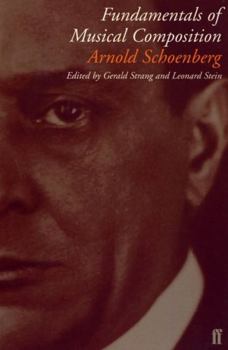Fundamentals of Musical Composition
Select Format
Select Condition 
Book Overview
Fundamentals of Musical Composition represents the culmination of more than forty years in Schoenberg's life devoted to the teaching of musical principles to students and composers in Europe and America. For his classes he developed a manner of presentation in which 'every technical matter is discussed in a very fundamental way, so that at the same time it is both simple and thorough'. This book can be used for analysis as well as for composition...
Format:Paperback
Language:English
ISBN:0571196586
ISBN13:9780571196586
Release Date:March 1999
Publisher:Faber & Faber
Length:240 Pages
Weight:0.72 lbs.
Dimensions:0.7" x 6.0" x 9.2"
Customer Reviews
4 ratings
I think Schoenberg might be part Vulcan...
Published by Thriftbooks.com User , 18 years ago
I don't particularly like Schoenberg's music, but I think he does quite well in this book, which primarily covers musical form ranging from the tiniest motif to the complete sonata. He goes into detail about how each part of a piece is structured from ever smaller elements down to the phrase and the motifs within it. Over all, it really does cover the fundamentals of musical composition well. The book covers a number of common musical forms in classical music, including minuets, scherzos, theme-and-variation, and the sonata-allegro form. I was somewhat dissappointed to see that important forms like the concerto and the tone poem were not covered, and it should be noted that Schoenberg focuses mainly on form in this book rather than harmony. However, the approach presented in the book strikes me as somewhat contrived and mechanical and I find it hard to believe that Beethoven thought to himself "hmm, maybe I should invert the motif in measure 2 and repeat it at a different interval in measure 3". Other than that, though, it is mostly quite useful, though certainly not light reading.
Designed as a text for student composers wanting to learn the basics of musical form
Published by Thriftbooks.com User , 18 years ago
Schoenberg worked on this text as part of his work with students at UCLA. He worked on it until his death in 1951 and had revised it several times. It is meant for students of composition rather than general music students studying form. The terminology is often Schoenberg's own and he, of course, has many interesting and strongly held views and approaches. It is not a text on twelve-tone composition, but of traditional and classic forms. It was written in English rather than Shoenberg's native German, but he had the help of this volume's editor, Gerald Strang. In this edition, many of Schoenberg's specially composed examples were replaced by examples from the literature and the proprietary examples moved to the volume "Structural Functions of Harmony". This is meant to serve as a very fundamental discussion of these matters for students who are thinking about becoming composers.
One of the best works on musical forms
Published by Thriftbooks.com User , 23 years ago
Arnold Schoemberg clearly demonstrates, through examples taken from baroque, classical and romantical pieces, the stuctural aspect of music; its small units, such as subjects, themes and phrases are explained in rich detail; the musical forms, like the minuet, rondo and sonata are also shown in full detail, allowing every music student to make contact with basic and advanced composition techniques. However, this is not for begginers, since advanced theory and harmony is required for full understanding. Like Schoemberg's "Theory of Harmony", this book doesn't contain material on twelve-tone composition and its specific forms, unfortunately.
Excellent introductory material about musical form.
Published by Thriftbooks.com User , 27 years ago
This is an excellent book for musicians interested in dabbling in composition. It defines the basic terminology frequently used in composition and discusses the common forms: scherzo, theme and variations, rondo, and sonata-allegro. One of the most important things about this book is probably that it does not focus upon the theoretical aspect of music at all. Experience in harmonic structure is not necessary to read this book, although ability to read music is. Most examples are excerpts from common pre-20th century composers such as Bach, Haydn, Mozart, Beethoven, Brahms, etc. This book is an essential to any musician's library. Even performers can benefit by understanding the forms common in standard repertoire. However, for someone specifically looking for information about harmonic theory, this book provides very little useful information.





